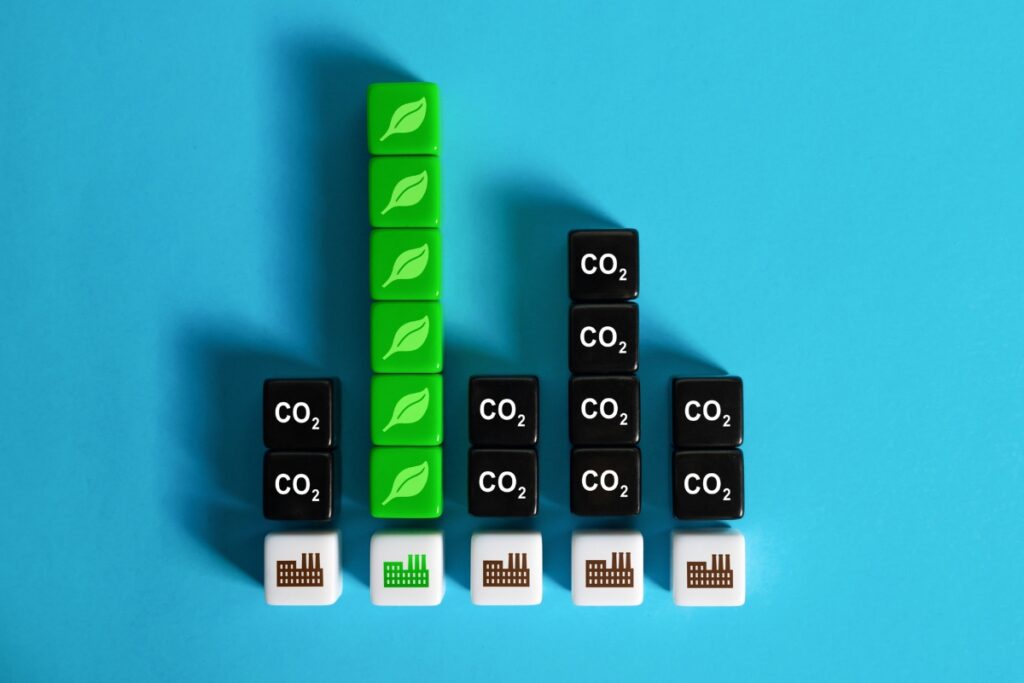Unsurprisingly, in recent times, manufacturing has been cited as a strategic target for carbon footprint reduction. In 2020, according to the Atmospheric emissions: greenhouse gases by industry and gas dataset, manufacturing was responsible for approximately 17% of greenhouse gas emissions in the U.K.
It is, therefore, easy to see why manufacturers now recognise this issue during business planning when external analysis highlights political, economic, social, technological, environmental and legal issues. This article introduces seven ways manufacturers can reduce their carbon footprint.

Reducing the Carbon Footprint
Planning a course of action to reduce the carbon footprint requires consideration across all aspects of a manufacturing business. When considering how to achieve the various goals, there are focus points that can help. These include:
- substitution of less eco-friendly technologies for those that are more eco-friendly
- the three R’s – reduce, reuse and recycle
- monitoring and continuous optimisation towards carbon footprint reduction
The following points explore some of these goals and focus points.
Recycling
Recycling is now a universal term; it is often the first step we think of to become more eco-friendly. Manufacturers can support this by setting company-wide recycling goals and introducing supporting policies, processes and culture change.
For instance, every manufacturer has highly active locations, such as delivery-in, delivery-out and the assembly line, where waste is high. Therefore, sending waste for recycling should face little resistance at these locations and packaging use should be minimised.
The overall recycling process can be aided by choosing suppliers of resources that offer more sustainable packaging and, internally, by using product development to design sustainable packaging for manufactured products.
As another example, production is heavily dependent on machines, and over time, components need replacing. However, some of these components can be re-manufactured, a process by which the old becomes the new.
Energy Usage
Transitioning from fossil fuels to renewable energy reduces a business’s carbon footprint and may yield cost savings. There are a few options for doing so.
Consciously choosing a greener energy supplier will reduce the footprint of energy consumption. Also, investment in green energy by using onsite renewable sources such as solar, wind, biomass and thermal will have an impact. Although an initial investment may be required, there may be savings further down the road.
Furthermore, manufacturers can choose machines that are more efficient and consume less energy, aiming for reduced energy consumption.
Initiatives can also encourage reduced energy use through schemes such as cycle to work.
Supply Chains and Material Choice
An audit of the entire supply chain is necessary to maximise the scope for reducing the carbon footprint.
Choosing a low-carbon footprint supplier would help ensure that a manufacturer’s overall footprint across the supply chain remains low. However, from suppliers of raw materials, machinery, logistics and packaging, to name a few, if these suppliers have a high footprint, then it will be almost impossible to keep the overall footprint of the supply chain to a minimum. Therefore, supplier choice becomes crucial to reduce the supply chain’s total carbon footprint.
Within product development, the choice of materials also has an impact. If substitute materials offer a lower footprint, they should be considered.
Equipment Efficiency
Increasing the efficiency of the machines used in manufacturing will reduce the energy utilised to manufacture a single product, lowering carbon emissions for each unit of product produced. Hence, the choice of machinery will reduce the carbon footprint and may provide cost savings.
Operational efficiency also contributes to a lower carbon footprint by maximising yield by reducing idle running and downtime of machines. Hence, keeping machines at optimal performance through servicing and calibration leads to a continuity of production and a subsequent increase in efficiency. An example of such a service is CMM Calibration and Servicing.
Logistics
Logistics is an obvious target for carbon footprint reduction due to the pollution it causes. Manufacturers depend on vehicles to transport raw materials and components used during assembly, carrying machinery and spare parts to and from sites and delivering goods to customers.
When considering third-party logistics services, consideration should be given to the carbon footprint they add to the supply chain. Internally, manufacturers can adopt green policies and guidelines to choose eco-friendly suppliers for those services.
Likewise, manufacturers can take a similar approach when carrying out their logistics.
By focusing on internal and third-party services, efforts can be made to reduce the carbon footprint through greener logistics.
Monitoring and Optimisation
Like other processes, footprint reduction requires monitoring to meet strategic targets and operational metrics. Therefore, a suitable monitoring system should be devised, incorporating measurement points at appropriate locations that allow emissions to be accurately recorded in a controlled environment. In addition, before any reduction activities are carried out, an initial set of measurements should be undertaken to provide a baseline from which future measurements can be compared.
Through automation and digitisation, a monitoring system could provide a real-time or near-real-time presentation of information that will assist with operational decision-making and culture shift.
Reporting of monitoring information should be shared with stakeholders in the reduction plan. This will facilitate ongoing motivation and success.
Industry advancements
Increasing awareness of new technologies, whether new equipment or processes, gives a manufacturer the opportunity for quick wins and continuous progression towards a greener business. For example, additive manufacturing (also known as 3D printing) is a new technique through which less waste can be produced during the production of components or prototypes.
Further to the advancement of technologies is the potential availability of financial support. With governments and industry strongly advocating greener businesses, there has previously been financial support, which will likely continue.
By keeping abreast of advancements, a manufacturer can position their business for the opportunity that carbon footprint reduction presents.
Moving Forward
Navigating carbon footprint reduction commences with research and a subsequent decision to incorporate a reduction strategy into the business cycle. It will ultimately require a culture shift and monitoring for maximum effect. All manufacturers have the capability for some common-sense reductions at the outset with minimal disruption. As a reduction strategy develops, so will the benefits it brings.

Jeff Eley is the founder and managing director of Eley Metrology, a leading company in the precision measurement industry. With decades of experience in metrology, Jeff has established himself as a respected figure in the field. Under his leadership, Eley Metrology has become renowned for its expertise in coordinate measuring machines (CMMs), digital height gauges, and granite metrology products. Jeff’s vision has driven the company to develop innovative solutions, including custom-designed CMMs and the flagship long-bore measurement machine (LBM). His commitment to excellence and customer-centric approach has positioned Eley Metrology as a trusted provider of high-precision measurement tools and services for industries such as aerospace, automotive, and manufacturing.


